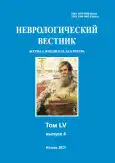Deviant behavior in adolescents: the role of non-suicidal self-harm, depression and the desire to find new sensations
- Authors: Antokhina R.I.1, Antokhin E.Y.1, Nemtseva E.K.1
-
Affiliations:
- Orenburg State Medical University
- Issue: Vol LV, No 4 (2023)
- Pages: 50-55
- Section: Brief communications
- Submitted: 11.12.2023
- Accepted: 14.12.2023
- Published: 15.12.2023
- URL: https://journals.eco-vector.com/1027-4898/article/view/624445
- DOI: https://doi.org/10.17816/nb624445
- ID: 624445
Cite item
Abstract
BACKGROUND. Although previous studies have shown that deviant predisposition is an important risk factor for non-suicidal self-harming behavior, the reasons for this relationship are unclear.
AIM. The purpose of the study is to identify the features of deviant behavior, the level of depression and the desire to search for new sensations in adolescents with non-suicidal self-harming behavior.
MATERIALS AND METHODS. At the first stage, 154 adolescents with a history of self-harming behavior were examined. At the second stage, using the Colombian Scale of Severity of suicidal Intentions, 149 adolescents with only non-suicidal self-harming behavior were selected from the entire sample (31.50% of them boys and 68.50% of girls, the average age was 16.35 years; SD=1.15). The study excluded 5 adolescents who had self-harmed for suicidal purposes. Columbia Scale of severity of suicidal intentions, Razuvaeva Suicide Risk Questionnaire, Bass–Perry Aggression Level Questionnaire, Diagnostic questionnaire to identify the propensity to various forms of deviant behavior for students of general education institutions, A. Beck’s depression questionnaire, Diagnosis of the needs of new sensations by M. Zuckerman, methods of descriptive statistics, r-Spearman correlation analysis.
RESULTS. Persons prone to aggressive behavior in general are more likely to show inconsistency, demonstrativeness, poorly developed time perspective and uniqueness. Teenagers who have a poor idea of the future (a weak time perspective) are characterized by a high level of general aggressiveness, hostility, physical aggression, as well as a desire to search for sensations. Adolescents with depressive syndrome with feelings of insolvency, helplessness, are prone to deviant behavior in general, and to the search for new sensations.
CONCLUSION. The correlation analysis revealed statistically significant correlations of aggression, autoaggression, deviant behavior, desire for sensation seeking and depression in adolescents. The results of our study provide the basis for an intervention aimed at preventing and reducing adolescent NSSP and deviant behavior in general.
Full Text
About the authors
Rosalia I. Antokhina
Orenburg State Medical University
Author for correspondence.
Email: rozaliana8@mail.ru
ORCID iD: 0000-0003-1761-1337
SPIN-code: 2041-8844
Senior Lecturer, Depart. of Clinical Psychology and Psychotherapy
Russian Federation, OrenburgEvgeny Yu. Antokhin
Orenburg State Medical University
Email: antioh73@yandex.ru
ORCID iD: 0000-0001-6835-8613
SPIN-code: 5875-2889
M.D., Cand. Sci. (Med.), Associate Professor; Head of the Department of Clinical Psychology and Psychotherapy
Russian Federation, OrenburgEkaterina K. Nemtseva
Orenburg State Medical University
Email: rozaliana8@mail.ru
ORCID iD: 0000-0002-2770-7888
SPIN-code: 6145-1202
Assistant, Depart. of Clinical Psychology and Psychotherapy
Russian Federation, OrenburgReferences
- Antokhina RI, Antokhin EYu, Boldyreva TA. Neurocognitive profile of young adults prone to self-harm. Psychiatry and psychopharmacotherapy. 2020;22(4):25–30. (In Russ).
- Geoffroy MC, Bouchard S, Per M et al. Prevalence of suicidal ideation and self-harm behaviours in children aged 12 years and younger: A systematic review and meta-analysis. Lancet Psychiatry. 2022;9(9):703–714. doi: 10.1016/S2215-0366(22)00193-6.
- Liu RT, Walsh RFL, Sheehan AE et al.. Prevalence and correlates of suicide and nonsuicidal self-injury in children: A systematic review and meta-analysis. JAMA Psychiatry. 2022;79(7):718–726. doi: 10.1001/jamapsychiatry.2022.1256.
- Pichikov AA, Popov YuV. Features of suicidal behavior in adolescents (literature review). Review of Psychiatry and Medical Psychology named after VM Bekhterev. 2011;4:4–8. (In Russ).
- Gould MS, King R, Greenwald S et al. Psychopathology associated with suicidal ideation and attempts among children and adolescents. J Am Acad Child Adolesc Psychiatry. 1998;37:915–923.
- Reinherz HZ, Giaconia RM, Silverman AB et al. Early psychosocial risks for adolescent suicidal ideation and attempts. J Am Acad Child Adolesc Psychiatry. 1995;34:599–611.
- Patton GK, Coffey S, Sawyer SM et al. Global patterns of youth mortality: A systematic analysis of population health data. Lancet. 2009;374:881–892.
- Lansford JE, Dodge KA, Fontaine RG et al. Peer rejection, affiliation with deviant peers, delinquency, and risky sexual behavior. J Youth Adolesc. 2014;43(10):1742–1751. doi: 10.1007/s10964-014-0175-y.
- Kentopp SD, Conner BT, Fetterling TJ et al. Sensation seeking and nonsuicidal self-injurious behavior among adolescent psychiatric patients. Clin Child Psychol Psychiatry. 2021;26(2):430–442. doi: 10.1177/1359104521994627.
- Bresin K, Hunt RA. The downside of being openminded: The positive relation between openness to experience and nonsuicidal self-injury. Suicide Life Threat Behav. 2023;53(2):282–288. doi: 10.1111/sltb.12943.
- Wei C, Li J, Yu C et al. Deviant peer affiliation and non-suicidal self-Injury among Chinese adolescents: Depression as a mediator and sensation seeking as a moderator. Int J Environ Res Public Health. 2021;18(16):8355. doi: 10.3390/ijerph18168355.
- Guan K, Fox KR, Prinstein MJ. Nonsuicidal self-injury as a time-invariant predictor of adolescent suicide ideation and attempts in a diverse community sample. J Consult Clin Psychol. 2012;80:842–849.
- Nock MK. Self-injury. Annu Rev Clin Psychol. 2010;6:339–363.
- Yu C, Xie Q, Lin S et al. Cyberbullying victimization and non-suicidal self-injurious behavior among chinese adolescents: School engagement as a mediator and sensation seeking as a moderator. Front Psychol. 2020;11:572521. doi: 10.3389/fpsyg.2020.572521.
Supplementary files






